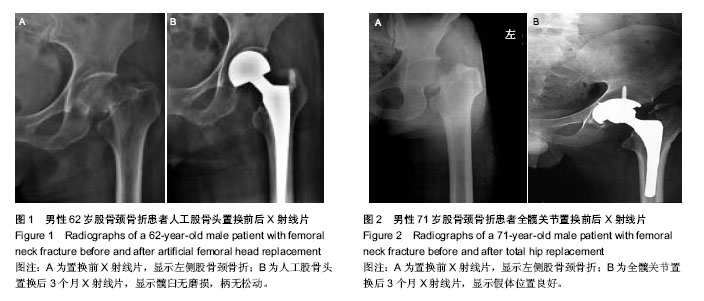| [1] 袁堂波,黄立新,蒋建农,等.双极人工股骨头置换术与全髋关节置换术治疗老年股骨颈骨折疗效比较[J].实用骨科杂志,2013, 19(6): 485-487.
[2] Gocen Z, Sen A, Unver B, et al. The effect of preoperative physiotherapy and education on the outcome of total hip replacement:a prospective randomized controlled trial.Clin Rehabil. 2003,18(4):353-358.
[3] 高祥彬.单纯股骨颈骨折与髋关节骨病患者髋臼杯放置位置与髋关节功能临床研究[D].苏州:苏州大学, 2013.
[4] 杨宗酉,邢欣,张奇,等.股骨颈骨折诊断和治疗关键技术研究进展[J].中华创伤杂志,2014,30(3):274-276.
[5] 卢永辉.人工髋关节置换术分类[J].中华关节外科杂志:电子版, 2007,1(3):182-183.
[6] 宋华.人工髋关节置换治疗老年股骨颈骨折的回顾性研究[D].济南:山东大学,2011.
[7] 孙振辉,刘月驹,李衡.髋关节置换与内固定术治疗老年移位型股骨颈骨折术后再手术率和并发症的系统评价[J].中华创伤骨科杂志,2014,16(2):115-121.
[8] 杨发民.改良撬拨闭合复位内固定修复复杂股骨颈骨折及内固定植入物的选择[J].中国组织工程研究,2014,8(22): 3463-3468.
[9] 赵杰青,朱曙,张西金,等.人工股骨头置换术治疗高龄股骨颈骨折[J].临床骨科杂志,2014,17(2):176-177.
[10] McKinley JC, Robinson CM. Treatment of displaced intracapsular hip fractures with total hip arthroplasty: comparison of primary arthroplasty with early salvage arthroplasty after failed internal fixation. J Bone Joint Surg Am. 2002;84-A(11):2010-2015.
[11] Godoy Monzón D, Iserson KV, Jauregui J, et al. Total hip arthroplasty for hip fractures: 5-year follow-up of functional outcomes in the oldest independent old and very old patients. Geriatr Orthop Surg Rehabil. 2014;5(1):3-8.
[12] Rogmark C, Fenstad AM, Leonardsson O, et al. Posterior approach and uncemented stems increases the risk of reoperation after hemiarthroplasties in elderly hip fracture patients. Acta Orthop. 2014;85(1):18-25.
[13] 张时文,李宣明.全髋关节置换术与人工股骨头置换术治疗高龄股骨颈骨折的疗效比较[J].中华创伤杂志,2014,30(7):692-694.
[14] 田敏,崔存宝,王东辰,等.老年股骨颈骨折人工髋关节置换67例临床报告[J].中国矫形外科杂志,2014,22(14):1325-1327.
[15] Hedbeck CJ, Blomfeldt R, Lapidus G, et al. Unipolar hemiarthroplasty versus bipolar hemiarthroplasty in the most elderly patients with displaced femoral neck fractures: a randomised, controlled trial. Int Orthop. 2011;35(11): 1703-1711.
[16] Inngul C,Hedbeck CJ,Blomfeldt R,et al. Unipolar hemiarthroplasty versus bipolar hemiarthroplasty in patients with displaced femoral neck fractures: a four-year follow-up of a randomised controlled trial. Int Orthop. 2013;37(12): 2457-2464.
[17] 张学斌,沈业彤,张子玉.全髋关节与人工股骨头置换术治疗股骨软骨折的疗效对比[J].中国老年学杂志,2014,6(31): 1640-1641.
[18] 郝吉林,郭景芳,陈焱,等.全髋关节置换术与人工双极股骨头置换术治疗老年新鲜移位股骨颈骨折的近期疗效比较[J].疑难病杂志, 2013,12(12):944-945,949.
[19] 陆春峰.人工关节置换术治疗老年股骨颈骨折疗效观察[J].齐齐哈尔医学院学报,2013,34(19):2888-2890.
[20] 杨立军.全髋关节和双极人工股骨头置换术用于老年股骨颈骨折治疗的对比分析[J].中国医药指南,2014,10(11):88.
[21] 马晓程,杨彬,彭明.全髋关节置换术与人工股骨头置换术治疗股骨颈骨折的效果对比分析[J].中国实用医药,2014,3(8):21-22.
[22] Dalldorf PG, Banas MP, Hicks DG, et al. Rate of degeneration of human acetabular cartilage after hemiarthroplasty. J Bone Joint Surg Am.1995;77(6):877-882.
[23] 黄沛冠,王摇蓓,谭光华,等.两种人工髋关节置换术治疗老年股骨颈骨折的临床体会[J].中南医学科学杂志,2014,42(3):314-315.
[24] 右张宁,李叔强,李冬松,等.全髋关节置换术与人工双极股骨头置换术治疗老年新鲜移位股骨颈骨折的近期疗效比较[J].中国矫形外科杂志,2011,19(4):268-271.
[25] 宋旗.全髋关节置换与人工股骨头置换治疗老年人股骨颈骨折的疗效比较[J].中国基层医药,2014,12(20):1820-1822.
[26] Liu YJ, Xu B, Li ZY, et al. Quantitative score system for the surgical decision on adult femoral neck fractures. Orthopedics. 2012;35(2):e137-143. doi: 10.3928/01477447-20120123-09.
[27] Kannan A, Kancherla R, McMahon S, et al. Arthroplasty options in femoral-neck fracture: answers from the national registries. Int Orthop. 2012;36(1):1-8.
[28] 刘二涛,徐皓,陈建梅,等.李金泉金属对金属大直径股骨头全髋关节置换术的临床应用及近期疗效观察[J].临床外科杂志,2013, 21(4):294-296.
[29] 张文彬.全髋关节置换和人工股骨头置换治疗老年股骨颈骨折的效果比较[J]. 南通大学学报:医学版,2013,33(4):295-297.
[30] Kanto K, Sihvonen R, Eskelinen A, et al. Uni- and bipolar hemiarthroplasty with a modern cemented femoral component provides elderly patients with displaced femoral neck fractures with equal functional outcome and survivorship at medium-term follow-up. Arch Orthop Trauma Surg. 2014; 134(9):1251-1259. |





